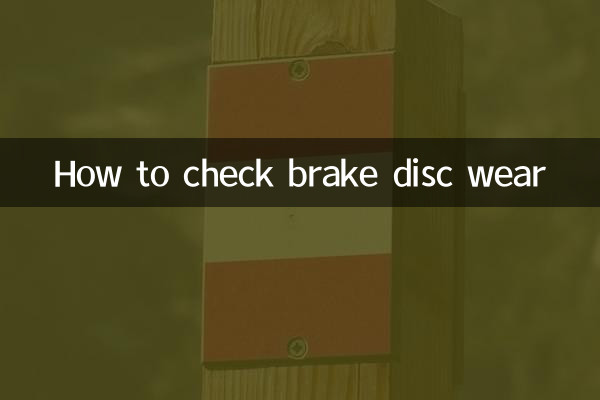How to Check Brake Disc Wear: A Comprehensive Analysis and Practical Guide
As the core component of the vehicle braking system, the brake disc's wear status is directly related to driving safety. Recently, discussions about brake disc wear have soared in major automotive forums and social platforms. Novice drivers, in particular, have many questions about how to judge the degree of wear. This article will combine hot discussion content across the Internet and give you detailed answers through structured data.
1. Typical manifestations of brake disc wear

When the brake disc exhibits the following symptoms, it often indicates the need for inspection or replacement:
| Symptoms | Possible reasons | Hazard level |
|---|---|---|
| Steering wheel shakes when braking | The brake disc is deformed or uneven | ★★★ |
| Sharp metal friction sound | Wear has reached the limit (alarm plate contact) | ★★★★ |
| Braking distance is significantly extended | Friction coefficient decreases | ★★★ |
2. How to detect the degree of wear yourself
You can initially determine the brake disc status through three simple steps:
| Check items | Qualification standards | measuring tools |
|---|---|---|
| Thickness measurement | Not less than 70% of the original thickness (most models ≥ 22mm) | Vernier caliper |
| Groove depth | One side≤1.5mm | depth gauge |
| surface condition | No cracks/severe rust | Visual inspection |
3. Comparison of brake disc wear of different materials
According to the latest industry statistics (third quarter of 2023):
| Material type | Average lifespan (10,000 kilometers) | Replacement cost (yuan/pair) | Applicable models |
|---|---|---|---|
| Ordinary cast iron plate | 6-8 | 400-800 | Economical family car |
| Ventilated perforated tray | 8-12 | 1200-2000 | performance sedan |
| ceramic composite disc | 15+ | 5000+ | luxury model |
4. Practical tips to extend the life of brake discs
Compiled based on the recent highly praised content of Douyin’s #Car-Maintaining Tips topic:
| Maintenance method | Operational points | Improved effect |
|---|---|---|
| Regular cleaning | Clean brake dust every 5000 kilometers | Reduce abnormal wear by 30% |
| Avoid sudden braking | Predict in advance to keep distance between vehicles | Extend life by 40-50% |
| Rainy and dry | Low speed light brake water removal film | Prevent rust and adhesion |
5. Professional suggestions and precautions
1.Replacement time:When the wear amount exceeds the manufacturer's standard (usually 2-3mm), it must be replaced. Some high-end models are equipped with wear sensors.
2.Matching replacement:It is recommended to replace the brake discs and brake pads on both sides of the coaxial axis at the same time to avoid unbalanced braking force.
3.Breaking-in period:New brake discs require a running-in period of 200-300 kilometers. During this period, avoid sudden braking under heavy loads.
4.Warranty policy:Mainstream brands (such as Brembo, ATE) provide a 2-year warranty, and claims for non-human damage can be made.
The recent Baidu Index shows that the search volume for "brake disc replacement cycle" increased by 67% week-on-week, indicating that car owners' safety awareness has significantly improved. It is recommended to conduct professional inspection every 10,000 kilometers or during maintenance to ensure that the braking system is always in optimal condition.

check the details

check the details